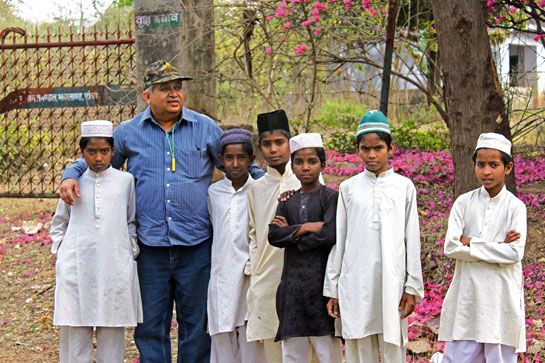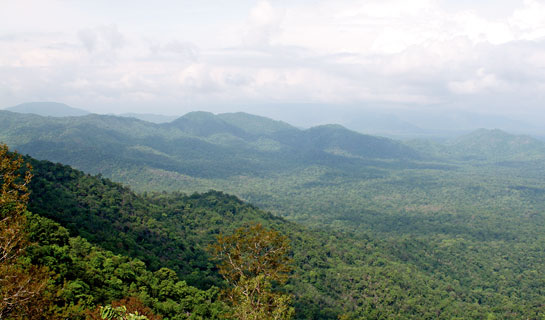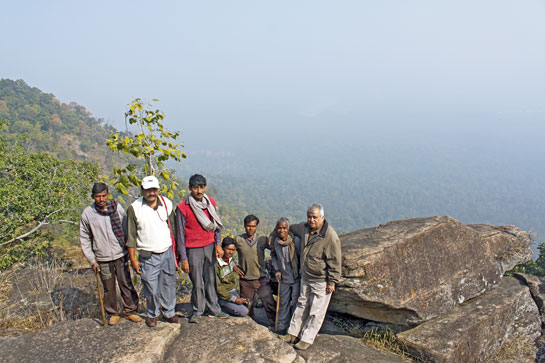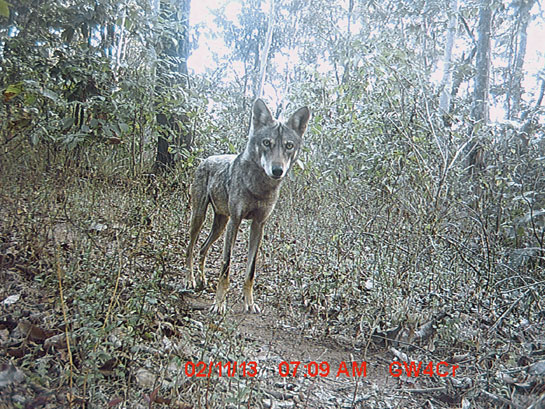Meet S.E.H. Kazmi
First published in Sanctuary Asia,
Vol. 36
No. 11,
November 2016
Bittu Sahgal speaks to Sanctuary's Lifetime Service Award winner of 2016 S.E.H. Kazmi, who has had a profound influence on the conservation map of Palamau and Hazaribagh for over three decades and will continue to do so.
How did the nature bug bite you?
I was born in Lucknow where my father was a college lecturer. He retired when I was nine years old and we moved to Rasoolpur, our ancestral village in Barabanki district, some 90 km. from Lucknow. Then, Rasoolpur, located a couple of miles from the huge sandy bed of the winding Ghaghra river, thrived with small and medium-sized wildlife. Nilgai roamed in the fields and mango orchards, civet cats frolicked on the dilapidated walls of our house, foxes teased our dogs who would chase them in vain, jackals howled through the night, birds dined with us on the verandah and the houses very own monitor lizard often created much chaos by sneaking near the chullah before she was shooed away. My mother was fascinated by a huge python that lived a few metres beyond the house, even naming it ‘Cheet', after its coat pattern. The only creatures we were warned about were snakes and scorpions, of which there were plenty. I would often see wolves roaming in the vicinity of the house. We children often imagined wolves jumping out of the Pataawar bushes on our way to school. My family, while not explicitly encouraging me to be an animal lover, implicitly inculcated a love for nature and its myriad beings by never stopping me from spending time outdoors.
And this love persisted?
My school's classroom was a parcel of open-shaded ground under a neem tree. When not in class, I explored the family orchard. What wonderful days they were! I was packed off to the small single-street town of Fatehpur to complete my matriculation, and from there, to Jaipur where I stayed for the next 12 years until I qualified for the Indian Forest Service (IFS) examination. If my rural background planted the seeds of nature appreciation, then my years in Jaipur nurtured it. Long walks with our dog, Narry, to Jhalana hills were a daily affair. Reading E. P. Gees The Wildlife of India provided me great insights. But it was a college trip to what was then the Darrah Wildlife Sanctuary (now a tiger reserve and one I recently revisited after 40 years, a few weeks after my retirement) that finally sealed my career path. There, I realised that my true calling lay in being with the Forest Department. In fact, I aspired to be a Range Officer, because I did not believe I was academically capable of even appearing for, forget qualifying, a UPSC examination. However, my brother-in-law, S.H.H. Kazmi had more faith in my capabilities and promised to back me financially and morally. I failed my first two attempts, but the late Kailash Sankhala sahib came to my rescue. I found his address in an issue of Sanctuary and cycled up to his house. What a generous and gracious man he was! I was warmly welcomed, offered a cup of tea, while he gave me a patient hearing as I spoke both about my interest in the services and my frustration. He offered encouraging words and one particular piece of advice stuck with me: “Forest Service ko tum jaise ladkon ki hi to zaroorat hai Kazmi, you must get through. Hausla rakho, mujhe poora vishwaas hai tum na kewal exam pass karoge balki ek bohot badhiya afsar banoge." (The Forest Department needs boys like you. Be sure that you will not merely pass, but be a great officer one day.) I returned with a confidence I had never felt before. I cleared the exam that year, seven years after I had first started preparing, and became a member of the 1985 batch of the Indian Forest Service. I will also never forget the support I got from Abhijit Ghosh sir, the-then Divisional Forest Officer (DFO) of the Jaipur Division, an upright officer and a wonderful human being.

Photo: Raza Kazmi.
How did you survive 30 years in the system?
I am a very spiritual person, and always feel a deep sense of wonderment at Khuda ki qudrat or God's nature. There is this rubaai by the great Urdu poet Mir Anees, which I learned as a kid and perfectly describes my outlook: “Gulshan mein phiroon, ki sair-e-sahra dekhun; Ya maadan-o-koh-o-dasht-o-dariya dekhun; Har ja teri qudrat ke hain laakhon jalwe; Hairaan hun ke do aankhon se kya kya dekhun."Translated it means: “Should I tour the gardens, or roam the deserts; Or see the minerals and mountains or the forest and rivers; Everywhere there are God-created natures miracles; I am puzzled what I should see with my eyes." It is this sense of wonder that drives my passion for conservation. Also a deep sense of duty, to sincerely do my best irrespective of what others have done or are doing.
I remember your fight for Palamau.
Sadly, it is now a forgotten reserve and I doubt it will make a comeback. Despite being one of the original nine tiger reserves, with the law and order situation deteriorating in the early 1990s, it quickly slid into obscurity. So with most of east-central Indias Protected Areas. They have been given step-motherly-treatment by government and non-governmental organisations, conservationists and researchers. While there have been some positive developments post 2011 in terms of wildlife recovery and the forest staffs mobility, the factors that led to the deterioration of Palamau - political indifference and administrative apathy, massive shortage of permanent staff and the law and order situation, are worsening. Even if just the first two factors are taken care of (the current vacancy at guard and forester level is nearing a staggering 100 per cent), Palamau might make some sort of a comeback, notwithstanding left-wing insurgency. But at this moment, and I pray I am wrong, I don't see a light at the end of the tunnel.

Photo Courtesy: Raza Kazmi.
Will the people-park gap be bridged?
There are two ways to correct this widening divide. First, the Forest Department staff must be respectful and polite in their day-to-day dealings with locals. A smile, a polite word, an arm around the shoulder, a hug, a shared sitting space, a communal meal — all basic etiquette of according respect and dignity — will not just mend old fences and heal old wounds but also build new bridges, create new partnerships. There are instances when the locals feel abandoned by the department when it comes to high-stake issues such as mining, dams and other large-scale projects. It is critical that the department is seen standing shoulder to shoulder with the locals. This is exactly what we did in the Kutku Dam issue, and consequently earned a lot of goodwill. The Forest Department must also find the right balance to address the livelihood needs of forest dwellers who are dependent on the forest and the needs of forests and wildlife. For example, allow a local to take wood from the forest for his house repairs, but ensure that he uses a dead tree or fallen log and does not hack down a tree. Of course a dead tree or log has its biological importance but we need to lose some to win some. It has to be a carrot-and-stick policy; you have to give concessions on some issues, such as say on Minor Forest Produce collection and use, while taking a firm stand on others, such as hunting or felling. Each region will need to work out its own balance, spatially and temporally, based on local dynamics such as demography, history, tradition, culture and the prevailing socio-political scenario.
Second, staff vacancies at the forest guard and daily-wage tracker level must be filled. The forest guard is the most visible face of the Forest Department as well as the most easily accessible unit. When there are vacancies, a communication gap develops between the department and the locals. New recruits also need to be sensitised while dealing with villagers. During my two tenures in Palamau, I tried to develop these qualities in my staff, ensure that no innocent villager was ever hassled, and that even those detained for an offence were treated with dignity. When we went after the Katha mafia on a war footing in the mid-1990s, the offenders were all poor locals working on paltry wages given by the thekedaar, and only trying to eke out a living. The first couple of times, I would have to ask the offenders to sit with my team and order my staff to share food with the kathedis (the local term for those involved in illegal katha manufacture and smuggling). Soon, this became a part of our Standard Operating Procedure. And as I had hoped, such accused katehdis on their return post bail would bear no grudges against us, and usually desist from re-entering the trade. This is just elementary work ethics and basic human decency. And this is exactly what forest guards, especially the new and future recruits, must aim for — to become a part of the larger village family.
I also believe that there should be affirmative action in favour of locals in the recruitment of forest guards and daily-wage jobs especially as trackers. The Forest Department must provide as many meaningful livelihood opportunities as possible.
Switching to coal... an industry you have been locking horns with. Can coal and wildlife coexist?
No, never. There can be absolutely no co-existence. Wherever mining commences, the forests and wildlife will go. After we forced Central Coalfields Limited to abandon their ambitious Horilong Underground (UG) mining project that had strong political backing and would have wrecked the northwest portion of the Palamau Tiger Reserve, I had quite a few run-ins with the coal lobby during my tenure as the DFO, Hazaribagh (West) Division. Apart from incessantly raiding illegal coal extraction units and plugging its transport, I wrote several factual reports on various coal projects such as Ashoka, Piparwar, Magadh, Amrapali, Pakri-Barwadih and others. In those days, the standard procedure was to write ‘Nil in the space provided for describing the wildlife in the proposed project area and how the project would affect biodiversity. It was all part of what we today call as the ‘ease of doing business. As soon as I took charge of the division, I made it clear that ‘business could not go on as usual. I began a series of field visits, and held long discussions with locals, as well as with the staff. All this established the presence of not just significant wildlife, but also the presence of flagship species such as tigers, leopards, elephants and even gaur, which were believed to have gone extinct from the Hazaribagh landscape by the 1960s. All this was reflected in my comments on the project proposal files, along with warnings on the destruction these projects would unleash. Only time will tell how successful my team and I were in securing these forests. I may not be around when the final judgements are passed, but I hope the coming generation will ensure that forests, wildlife and people win this long-drawn battle.
And the status of the Hazaribagh-Palamau wildlife corridor now?
The situation has deteriorated considerably over the last decade. When I joined the Hazaribagh division in 1998, the corridor was healthy and functional, and in fact was a full-fledged landscape connecting two large forest landscapes, Palamau and Hazaribagh. I found ample signs of predators such as tigers, leopards and dholes, and elephants too regularly used it. In fact in December 2005, a tiger landed in the Hazaribagh Wildlife Sanctuary for the first time in 12 years, in all likelihood through this corridor. But over the years, mining has ravaged the Palamau-Chatra-Hazaribagh corridor and while the corridor may be physically present, it is functionally almost destroyed. Official apathy hasnt helped the cause. Another decade of mining without any protective and remedial measures will seal the corridors fate.

Photo: Raza Kazmi.
Are wildlife traders and MCC Naxals in league with locals?
That is a good question Bittu and one that I have been asked often. There is absolutely no connection between the wildlife trade and Maoists. Even though Maoists had a stake in the form of levies in illegal activities such as the katha smuggling and bidi patta/tendu patta trade, none of the Naxal outfits, be it the former MCC, or PU (Party Unity) or the present-day Maoists (post the 2004 merger between MCC and PW) have ever indulged or assisted in any poaching activities, nor in trafficking of wildlife contraband. The Naxals have issued diktats and made public proclamations against poaching and in favour of conservation in Jharkhand. However, their non-involvement in the wildlife trade is not because of altruism, but rather because it makes no economic sense. The movement finances itself through much bigger, easier and low-risk means in the form of an extensive ‘levy regime, which is incredibly profitable. Jharkhand alone is believed to be contributing hundreds of crores to Maoist coffers annually, an overwhelming bulk of which comes through levies extracted from various government infrastructure projects and mining firms (both public and private). The bidi patta trade (and formerly katha trade, which has ceased with the wiping off of exploitable khair trees from the state) forms a secondary source of income. The biggest drawback of Naxal presence and the resulting limited control (and complete ousting in some areas) of the Forest Department has been the exploitation by local bush-meat hunters, thus creating an ‘empty forest syndrome within the Red Corridor. Wary of jeopardising their support base, Naxals refrain from acting against such hunting, their public proclamations against such activities notwithstanding. They also, however, do not interfere when we take action against poachers. Overall, while Naxals do not poach or participate in the wildlife trade, the poor law and order situation in such areas allows other players to take advantage of the chaos.
You went undercover to bust poaching gangs too right?
Going undercover to bust smuggling gangs is always a dangerous proposition. But then if you cannot risk your life, do you have any moral right to ask someone else to risk theirs? This has been my position from 1995 when I first went undercover to 2011 when I camped in abandoned field posts or ‘out of bound areas. Many of our undercover operations were indeed pretty effective. Our largest seizure of wildlife contraband in Palamau took place in 1997 and then again when we went undercover in 2012 to recover a leopard skin.
Is wildlife contraband also stolen from official custody?
The contraband is fairly safe in a divisions headquarters. However, it should be burned from time to time in full public and media glare by government policy to further minimise any risks.

Photo Courtesy: Forest Department, Palamau Tiger Reserve.
Are wolves still being persecuted in Bihar and Jharkhand today?
While I cannot speak for their status in Bihar, wolves are doing fairly well in Jharkhand, one of the few species that can claim this tag. I studied them at the Mahuadanr Wolf Sanctuary during my first tenure in Palamau as the DFO. I would camp at the abandoned and crumbling forest rest house at Sarnadih by the Burha river — where Shahi sahib camped to take his now famous photographs of Mahuadanrs wolves. In fact, in a bid to revive the sanctuary, I had the Sarnadih rest house resurrected, and was the inaugural occupant. Sadly, I was also the last occupant, and post my transfer a couple of years later the rest house again fell into disuse. When I returned more than a decade later, now as Palamaus Field Director, I found the place to be in disarray. Thankfully, the wolf populations had remained stable. Villagers here continue to have remarkable tolerance towards wolves, and a few losses of goats and other small animals are taken in their stride. From 2011 onwards, I ensured that the losses were promptly compensated even if the amount fixed by the government was less than the market value. Interestingly, during our camera-trapping efforts in Palamau, a wolf was photographed not in Mahuadanr as expected, but rather from the forests of Garu, one of the densest areas in the heart of the tiger reserve. We would later also find pugmarks of wolves in the forests around Maromar. I later saw a photograph taken in 1988 by my friend and old Palamau hand, Prosenjit Das Gupta sahib of a wolf on the Garu-Maromar road. This made me wonder if these were transient and moving through dense forest patches to the more open fringe areas or had Palamaus wolves adapted to living in dense sal forests.
Wolves are found in most parts of the state and Hazaribagh is their other stronghold. The wolves of Hazaribagh were quite infamous during the colonial days and even until the 1980s as child lifters. Records suggest that they had caused significant human fatalities. Thankfully, not anymore, and man and wolf finally seemed to have inked a permanent truce in this landscape.
Any pivotal moment that changed your life?
A landmine blast targeted me on February 16, 1998. I was on the radar of the illegal Katha operators after I came down heavily on the trade from 1996 onwards. Our operations against the illegal Katha manufacturers were intense and we were raiding a khadsaal (katha manufacturing unit) almost every week causing the mafia to lose lakhs of rupees with every raid. Naturally, these guys wanted to eliminate me, and they finally got their opportunity during the 1998 Lok Sabha elections when they bribed a few grassroots MCC cadre to blow up the chhotka ujala gaadi (small white vehicle - my Gypsy). The turn of events was long and complicated (read about it online at www.sanctuaryasia.com), but my team and I disembarked from the vehicle at Labhar, and sent my driver Aziz Qureishi to pick up some food for our team in my car. Our tracker Sukhdeo Parahiya joined Aziz on his way back. The Naxals mistook Sukhdeo, who was sitting on my usual front seat, to be me, and the wrong people died. The MCC leadership apologised both publicly and privately, through mediators, explaining that the attack wasnt authorised and, that an ‘internal enquiry was being instituted. But the damage was done. Nothing would bring those two men back.
The incident cemented my belief that it's Allah's will whether you live or die. None of us, Aziz, Sukhdeo or I were supposed to be in that vehicle that day. I was the target. Why did Aziz and Sukhdeo have to die?
Near the end of my career, I requested my PCCF A. K. Singh, to post me back to Palamau one last time. As I prepared to return, a strange sense of foreboding overtook me. So one of the first things I did after taking charge was to return to the fateful site of the blast. I guided Nasim, my driver who understood nothing of the significance of my pilgrimage. The kuccha road my Gypsy took that fateful day had been taken over by the forest, but we managed to reach that nullah. I got down from the vehicle, walked to the exact spot and as I stood there reminiscing, I looked up the huge kahua tree - on whose branches, 20 or 30 m. above the ground, the doors of my Gypsy hung 13 years ago after the blast had ripped the vehicle apart.
Clear water flowed past the spots where Aziz and Sukhdeos mutilated corpses once lay. The forest was green. Birds chirped. Cicadas played their orchestra. It was all so peaceful. So serene. I sat down on the banks of the nullah and broke down. I recited a surah-e-fateha for the departed souls. As I got up to return, I felt a great load lifted off my chest. All self-doubts, apprehensions and the jitteriness of returning to Palamau had vanished.
A changed man, that day, I finally had my closure.
Give us three steps to save India's wilds.
1. We cannot hope to save our forests and wildlife unless communities do not find conservation efforts creating or augmenting their livelihoods and improving their quality of life. Beyond a few inviolate core areas, people and wildlife will have to coexist and community participation is critical. You cannot expect a villager to keep losing his crop to an elephant or his cattle to a tiger or leopard and not do anything. If aid and opportunities and the means to offset such economic losses are not forthcoming, he will retaliate. And when entire communities go against wildlife, no amount of policing will be able to save the day. History is replete with such examples. Another aspect is to help ease their problems. For example, water is central to village life, and hence water conservation measures will be appreciated. I built several water harvesting structures during my career, and people still come to me, to take me back to their villages to show me how those measures transformed lives and livelihoods. The Forest Department must be honest, helpful, respectful and dignified, in our dealings with communities. Do that and people will assist you with whatever they have and by joining forces, miracles happen.
2. Ensure that the law is enforced not just in letter but in spirit as well. A modicum of policing is a requisite in conservation just as needed in society. The balance between policing and community participation will vary regionally and temporally depending on factors mentioned earlier. Similarly, nothing will ever beat mud-on-boots foot patrols with a disciplined, sensitive and motivated ground staff. Vacancies must be filled and the staff (including the daily wage workers) must be provided with incentives on par with our armed forces especially in terms of pay bands, health insurances, allowances for difficult postings, and most importantly public recognition of their sacrifices and good work.
3. Create awareness about wildlife and forest conservation, not just in cities and towns but also the rural communities living in and around the forests. It is here where NGOs, conservationists and wildlife lovers can make a difference. We need more wildlife literature in vernacular languages, the wonderful content of a magazine like Sanctuary needs to reach the children in Garu, Betla, Kutku, Kujrum and so on. Scholarships must be created, local arts and crafts popularised and marketed, tribal children and their parents given free safaris through the park, perhaps even to areas that are normally out of bounds for tourists because the locals who bear the onus of conservation also deserve to be given a special status. I can guarantee you that say out of 20 such locals and children you reach, even if one goes on to become a conservationist, then the future of wild India is secured.
First published in: Sanctuary Asia, Vol. XXXVI No. 12, December 2016.





